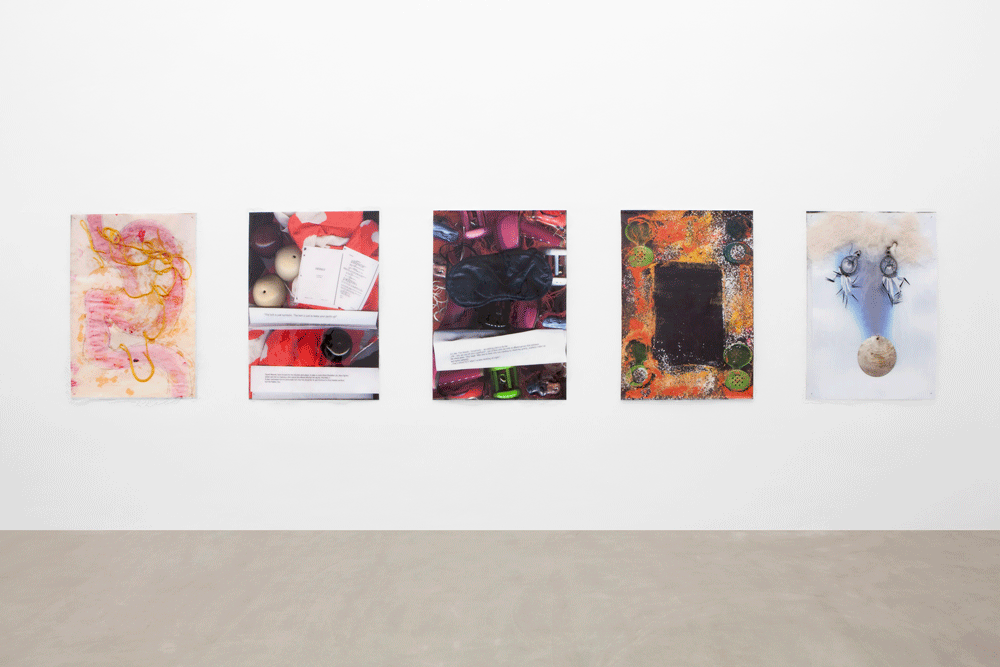Lucie Stahl
Galerie Meyer Kainer
Galerie Meyer Kainer

‘While he is talking about stuff, you are thinking about stuff. Your Stuff,’ reads a fragment of text depicted on Lucie Stahl’s poster-sized print Stuff (2008). The artist’s exhibition at Galerie Meyer Kainer brought together around 25 of her works from 2008 to 2011, which draw on the stuff – objects, materials and situations – that fixes individual lives within their cultural contexts, often triggering absurdities and misinterpretations.
All the works on display were based on the same production principle: Stahl arranges various found objects, ranging from magazine advertisements to scraps of wood and high-heeled shoes, powdery substances, liquids and short texts found or written by the artist and typed on white paper. These objects are placed on a scanner where they are captured two-dimensionally and then blown up to large-scale inkjet prints, which Stahl covers with polyurethane and fixes to the gallery walls – unframed, like posters – in groups of four or more. This production process not only adapts the Modernist photogram to contemporary technology, but also recalls 1960s cinematic attempts to directly engage with the medium of film by covering it with various liquids and acids. The blotches and smears that frequently appear on works like Vulgar Sentiments (2011) or Waste Obsession (2009) obscure and reduce the sense of immediacy that the scanning of found objects would otherwise convey.
Pieces such as Dick (2010) have a very literal connection between the works’ imagery, written material and their titles, which are taken from texts included in the works. In Dick, for example, a phallic black object is positioned on top of a man’s necktie and combined with an anecdote about a misogynist artist at a gallery dinner. Despite a surrealist juxtaposition of objects, the works rarely leave any space for hidden meanings. The abundance of objects that characterizes Superficial (2010), or the focus on individual consumer goods such as the chips package in Cheese Explosion (2010) or the designer bag in Patriotic Impulse (2009), combined with the striking glossy surfaces of the works, conveys a sense of cheap glamour, speaking of desire and repulsion, satisfaction and dissatisfaction.
Stahl often draws on recent pop-cultural imagery from advertising, Hollywood cinema and television. She also frequently introduces short anecdotes in a stand-up comedy-like tone, as well as first-person narratives in an almost modernist literary style. Snap (2009), for example, mentions a scene from the 2000 film X-Men within a seemingly autobiographical text about the artist’s inability to prevent thinking about her students even in the most private moments.
In his 1905 book on jokes and the unconscious, Sigmund Freud discussed the particular attributes of jokes, including brevity and references to familiar situations with slight modifications. These kinds of humorous elements, particularly in the form of visual or literary puns, find their way into most of Stahl’s work. However, her works don’t provoke outright laughter as much as they find subtle humour in gender stereotypes or situations and characters specific to the art world. In Erotic Thoughts (2011), for example, an invitation to participate in an exhibition results in a surreal-sounding email conversation about the inadequacy of the A4 format to represent one’s erotic thoughts.
The text on a folded piece of paper inscribed in Superficial mentions someone in a bar saying, ‘Oh – why are you all sooo superficial!’; the words resonate against a backdrop of a pair of pink high-heels and a black satin sleeping mask. Building on familiar yet displaced narrative bits and provocative objects like these, Stahl’s works trigger our curiosity about the objects’ and texts’ relationships to one another. With their glossy surfaces and messy aesthetics, however, they always keep the viewer at a distance, most effectively in those works where images and text collide.























